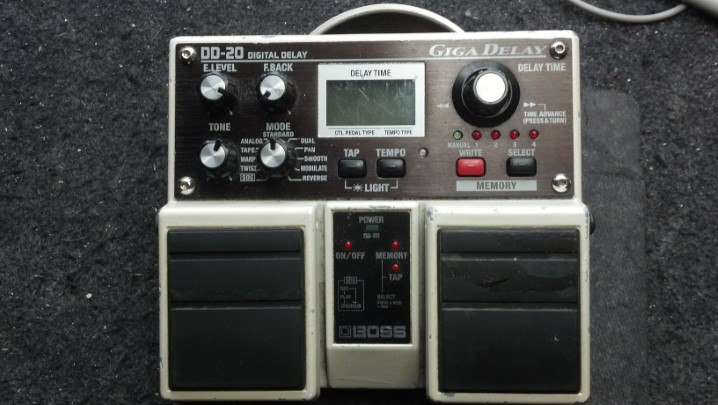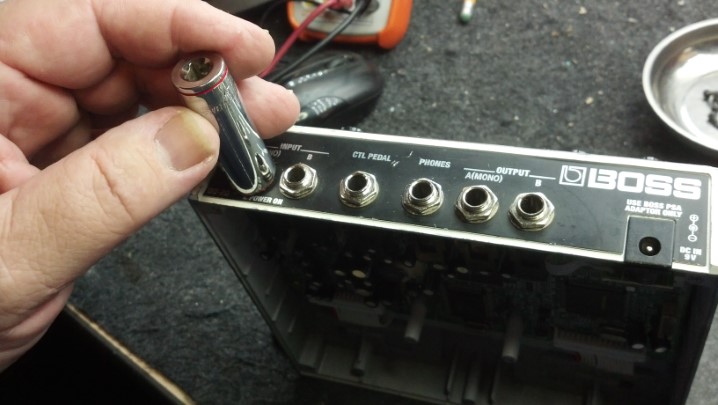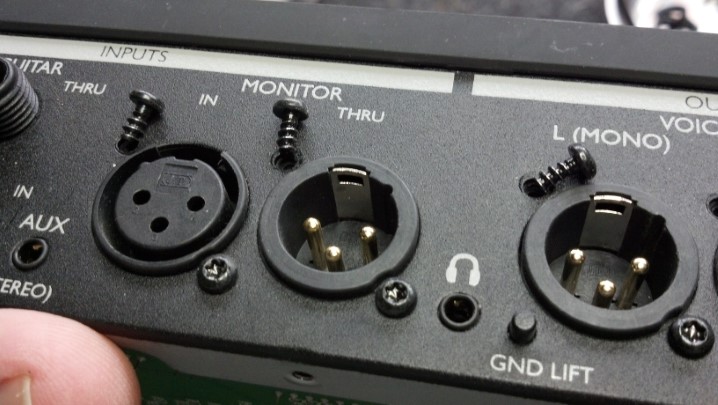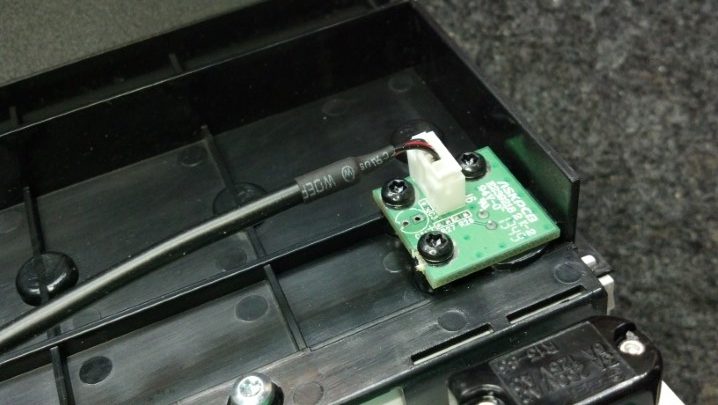Every function on this pedal works properly. Except, the user cannot select menu functions without a lot of hassle. And, the delay time can only be increased, not decreased. Can the Unbrokenstring Crew decode the mystery and make this unit a little less of a pain in the rear to use again?
 The unit turns on and works, but the delay time knob only increments. This makes it almost impossible to select any function or mode unless the user spins the knob all the way around to wrap back to the beginning of the menu. And there is, like, three hundred menu items.
The unit turns on and works, but the delay time knob only increments. This makes it almost impossible to select any function or mode unless the user spins the knob all the way around to wrap back to the beginning of the menu. And there is, like, three hundred menu items.
 Everything is accessible from the bottom. The vertical strips are Velcro hook material, to hold the pedal in place on the pedal board.
Everything is accessible from the bottom. The vertical strips are Velcro hook material, to hold the pedal in place on the pedal board.
 The black plastic rectangle on the left is a battery box. On the right is a stack of circuit boards.
The black plastic rectangle on the left is a battery box. On the right is a stack of circuit boards.
 Removing the circuit boards involves removing the nuts on these jacks.
Removing the circuit boards involves removing the nuts on these jacks.
 The ribbon cables interconnect the two main circuit boards.
The ribbon cables interconnect the two main circuit boards.
 The metal piece around the jacks is really part of the noise shielding of the box.
The metal piece around the jacks is really part of the noise shielding of the box.
 We can tip out the bottom board now that the jacks and power adapter jack is free from the rear panel.
We can tip out the bottom board now that the jacks and power adapter jack is free from the rear panel.
 Interestingly, this little crescent moon-shaped piece is a bushing that makes a small hole out of a large one. This may have been a design feature for another model of pedal, or, more likely, the result of an engineering change. Or, my favorite theory, a design screw-up.
Interestingly, this little crescent moon-shaped piece is a bushing that makes a small hole out of a large one. This may have been a design feature for another model of pedal, or, more likely, the result of an engineering change. Or, my favorite theory, a design screw-up.
 Back in the early days of electronics, stiffened cardboard was coated with wax to make insulating sheets called ‘fish paper.’ Nowadays, we have synthetic equivalents. This insulating sheet separates the two circuit boards.
Back in the early days of electronics, stiffened cardboard was coated with wax to make insulating sheets called ‘fish paper.’ Nowadays, we have synthetic equivalents. This insulating sheet separates the two circuit boards.
 To gain access to the top circuit board, we need to remove the control nuts on the top side. This is the knob for the delay select function. The knob works fine, the function it performs does not.
To gain access to the top circuit board, we need to remove the control nuts on the top side. This is the knob for the delay select function. The knob works fine, the function it performs does not.
 This plastic bushing covers a larger hole and allows the knob to be recessed below the plane of the top panel.
This plastic bushing covers a larger hole and allows the knob to be recessed below the plane of the top panel.
 These other controls are more conventional in their mounting scheme. Those hex drive screws are for looks, and only hold the bezel down on the top of the pedal enclosure. We don’t have to mess with them today.
These other controls are more conventional in their mounting scheme. Those hex drive screws are for looks, and only hold the bezel down on the top of the pedal enclosure. We don’t have to mess with them today.
 At long last, we are able to remove the upper circuit board.
At long last, we are able to remove the upper circuit board.
 We already have a pretty good idea that the rotary encoder for the delay function is not working properly. To verify that, the unit is partially reassembled for electrical test. The cardboard is more insulating material to keep everything from shorting out. Kinda like home-made fish paper.
We already have a pretty good idea that the rotary encoder for the delay function is not working properly. To verify that, the unit is partially reassembled for electrical test. The cardboard is more insulating material to keep everything from shorting out. Kinda like home-made fish paper.
 The unit is running and the oscilloscope can tell us if the two phases of signal are coming from the rotary encoder. The answer is, one phase is missing. Thus, the rotary encoder can only appear to electrically ‘spin’ in one direction.
The unit is running and the oscilloscope can tell us if the two phases of signal are coming from the rotary encoder. The answer is, one phase is missing. Thus, the rotary encoder can only appear to electrically ‘spin’ in one direction.
 So, it’s time for the old rotary encoder to come off the circuit board. A soldering iron will melt the solder and this Solda-Pullit will remove the molten solder.
So, it’s time for the old rotary encoder to come off the circuit board. A soldering iron will melt the solder and this Solda-Pullit will remove the molten solder.
 The new rotary encoder is installed, as shown. This rotary encoder also has a built-in momentary switch that is actuated when the shaft is pushed down towards the circuit board. Or, in use, when your foot taps the knob while playing.
The new rotary encoder is installed, as shown. This rotary encoder also has a built-in momentary switch that is actuated when the shaft is pushed down towards the circuit board. Or, in use, when your foot taps the knob while playing.
 Pretty nice workmanship, wouldn’t you say?
Pretty nice workmanship, wouldn’t you say?
 Re-assembly is the reverse of dis-assembly. There are a lot of parts here, so this unit will go back together with the help of all the pictures we took earlier.
Re-assembly is the reverse of dis-assembly. There are a lot of parts here, so this unit will go back together with the help of all the pictures we took earlier.
 The insulative sheet goes here.
The insulative sheet goes here.
 The bottom assembly goes here, with the requisite white cables. Don’t forget to re-install the little crescent-moon-shaped piece where the connectors poke through the back panel. I did, the first time. Oh, yeah, and the metal shield, too.
The bottom assembly goes here, with the requisite white cables. Don’t forget to re-install the little crescent-moon-shaped piece where the connectors poke through the back panel. I did, the first time. Oh, yeah, and the metal shield, too.
 Many of the Boss pedals use this barrel connector for power. The shell of the pedal housing slide into the slots molded in the connector to firmly hold the power connector in place. Note that not all barrel connectors have these slots. If you ever replace a Boss pedal power connector, verify that the replacement part has the slots.
Many of the Boss pedals use this barrel connector for power. The shell of the pedal housing slide into the slots molded in the connector to firmly hold the power connector in place. Note that not all barrel connectors have these slots. If you ever replace a Boss pedal power connector, verify that the replacement part has the slots.
 This is a little better shot that shows the proper orientation of the shield plate. The little sharp fingers around the outside edge should point away from the middle of the pedal, so that they can ‘bite’ into the pedal housing.
This is a little better shot that shows the proper orientation of the shield plate. The little sharp fingers around the outside edge should point away from the middle of the pedal, so that they can ‘bite’ into the pedal housing.
 The red and black cable carries power from the internal battery box that we saw in the picture above.
The red and black cable carries power from the internal battery box that we saw in the picture above.
 The unit is cleaned up and all the knobs reinstalled. Ready for test!
The unit is cleaned up and all the knobs reinstalled. Ready for test!
 All functions work flawlessly, PLUS the rotary delay time knob both increases and decreases delay time and allows the user to scroll up and down through the menus. I think we’re done here!
All functions work flawlessly, PLUS the rotary delay time knob both increases and decreases delay time and allows the user to scroll up and down through the menus. I think we’re done here!
Thanks for reading all the way to the end!
CONTACT – David Latchaw EE
281-636-8626

















































































